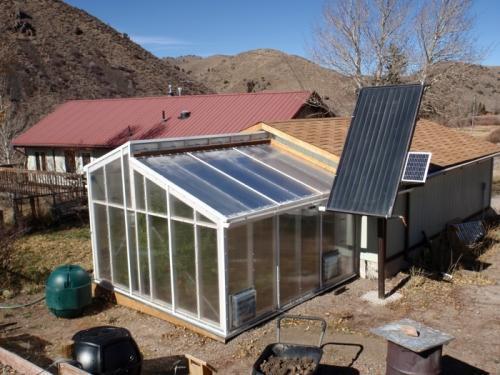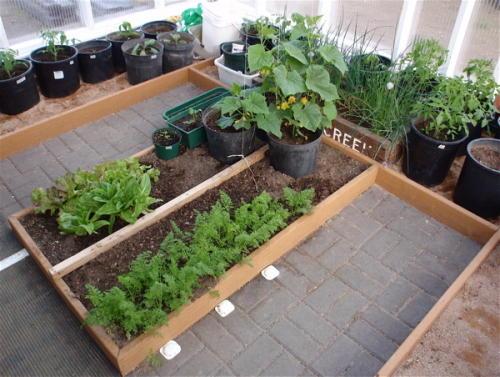DaisyI said:I live at 5000 feet in Reno, NV at the west edge of the Great Basin. We have very little snow or rain but do have wind, regularly over 50 mph, winter temperatures approaching 0 and summer highs near 100. My greenhouse is 5-wall super polycarbonate because of the wind and because I am growing mostly orchids.
My daughter has a twin-wall polycarbonate greenhouse but she does not try to keep it above freezing in winter and it is a little more protected from the wind. Check to see if twin-wall will withstand the winds in your area. I assume you will be using your greenhouse seasonally? Or are you growing in winter also?
No matter what, you will need some kind of heat. Daughter uses a small milk barn heater and it seems to work well but her GH is about half the size you are planning. The temperatures inside her GH do drop below freezing (upper 20's) but she is growing plants that can withstand the cold. There have been quite a few discussions on this Forum about propane heating. That may work for you but it must be installed and vented properly for your safety but also for your GH's. Kaboom!
I don't worry about summer heat. If you are building your own plan though, the more vents and doors, the better. I leave the door open all summer and have automatic roof and side vents built into the GH walls and roof. You can cool a GH down dramatically by adding a mister and covering the roof with shade cloth (I have both). If you decide to get a shade cloth, add some sort of support to hold it off the roof. Mine stays up all year round but I'm not worried about snow. The hardest part of shade cloth is getting it up there and down again. When I did remove it annually (old GH), I often though how handy it would be if the top of the GH had coyote bars on it.
Swamp coolers are popular for GH cooling. I did try that but decided it was more of a hassle then I wanted to deal with and it took up a lot of space.
The wind is a big factor. My greenhouse is engineered for 130 mph winds - its got steel I-beams as added support. If you are building a wooden frame, I would follow the local building code because it is designed for your local weather. In my area, that would be studs on 16" centers but as the walls in a house are part of the structure, you may need additional support. Don't forget the shear - in a regular building, that is the outside layer of plywood over the entire frame. Polycarbonate isn't going to provide a lot of shear.
Do you have a snow load? Luckily, we don't. But the more snow, the steeper the pitch in the roof. You want it to slide off, not fall through.
I would forget the metal corrugation around the bottom and instead put in a concrete stem wall and foundation to bolt the whole thing down to, just like attaching a house to a foundation. My stem wall is 12 inches high and the foundation is 18 inches deep - below the freeze depth. The floor of my GH is also concrete but sand and brick (like a patio) is also a good solution. You definitely want a floor. And drains. Build drains into the bottom of the stem wall. Add water pipes and faucets and electrical outlets as you build.
The best shelving is wire - that way the plants on the bottom get light from the top. My lowest plants are at the height of the stem wall, except for some large pots sitting on the floor. I use Closetmaid wire pantry shelves. One side is held up by hooks in the studs and other is held by chains and hooks from the ceiling. They come in 12, 16 and 20 inch widths and can be cut to size with bold cutters. As your plan is for a 10 ft wide GH, think about how wide the isles need to be and build something down the center. I had a wide GH at my old house; I used wire Baker's Shelves and hung things from the ceiling. This time around, I built a 6 ft wide GH so 16" shelves on either side and still over 3 ft down the middle.
Last summer, I added an automatic watering system on timers as I'm not good at remembering to water. The sprinklers are mounted on the ceiling and the water is able to get to all the plants on all the levels because of the wire shelves. It needs to run for only 2 minutes to thoroughly water everything.
Oh, polycarbonate sheeting... The edges need to be sealed somehow. On my GH, they are taped on the edges and held in place by metal frames but the entire GH is metal. I'm not sure what you would do with a wood structure but definitely something to look in to as something needs to hold the panels in place. If you don't seal the edges, the panels fill up with moisture (and bugs) and become opaque and gross.
Did I cover everything?



DaisyI said:I live at 5000 feet in Reno, NV at the west edge of the Great Basin. We have very little snow or rain but do have wind, regularly over 50 mph, winter temperatures approaching 0 and summer highs near 100. My greenhouse is 5-wall super polycarbonate because of the wind and because I am growing mostly orchids.
My daughter has a twin-wall polycarbonate greenhouse but she does not try to keep it above freezing in winter and it is a little more protected from the wind. Check to see if twin-wall will withstand the winds in your area. I assume you will be using your greenhouse seasonally? Or are you growing in winter also?
No matter what, you will need some kind of heat. Daughter uses a small milk barn heater and it seems to work well but her GH is about half the size you are planning. The temperatures inside her GH do drop below freezing (upper 20's) but she is growing plants that can withstand the cold. There have been quite a few discussions on this Forum about propane heating. That may work for you but it must be installed and vented properly for your safety but also for your GH's. Kaboom!
I don't worry about summer heat. If you are building your own plan though, the more vents and doors, the better. I leave the door open all summer and have automatic roof and side vents built into the GH walls and roof. You can cool a GH down dramatically by adding a mister and covering the roof with shade cloth (I have both). If you decide to get a shade cloth, add some sort of support to hold it off the roof. Mine stays up all year round but I'm not worried about snow. The hardest part of shade cloth is getting it up there and down again. When I did remove it annually (old GH), I often though how handy it would be if the top of the GH had coyote bars on it.
Swamp coolers are popular for GH cooling. I did try that but decided it was more of a hassle then I wanted to deal with and it took up a lot of space.
The wind is a big factor. My greenhouse is engineered for 130 mph winds - its got steel I-beams as added support. If you are building a wooden frame, I would follow the local building code because it is designed for your local weather. In my area, that would be studs on 16" centers but as the walls in a house are part of the structure, you may need additional support. Don't forget the shear - in a regular building, that is the outside layer of plywood over the entire frame. Polycarbonate isn't going to provide a lot of shear.
Do you have a snow load? Luckily, we don't. But the more snow, the steeper the pitch in the roof. You want it to slide off, not fall through.
I would forget the metal corrugation around the bottom and instead put in a concrete stem wall and foundation to bolt the whole thing down to, just like attaching a house to a foundation. My stem wall is 12 inches high and the foundation is 18 inches deep - below the freeze depth. The floor of my GH is also concrete but sand and brick (like a patio) is also a good solution. You definitely want a floor. And drains. Build drains into the bottom of the stem wall. Add water pipes and faucets and electrical outlets as you build.
The best shelving is wire - that way the plants on the bottom get light from the top. My lowest plants are at the height of the stem wall, except for some large pots sitting on the floor. I use Closetmaid wire pantry shelves. One side is held up by hooks in the studs and other is held by chains and hooks from the ceiling. They come in 12, 16 and 20 inch widths and can be cut to size with bold cutters. As your plan is for a 10 ft wide GH, think about how wide the isles need to be and build something down the center. I had a wide GH at my old house; I used wire Baker's Shelves and hung things from the ceiling. This time around, I built a 6 ft wide GH so 16" shelves on either side and still over 3 ft down the middle.
Last summer, I added an automatic watering system on timers as I'm not good at remembering to water. The sprinklers are mounted on the ceiling and the water is able to get to all the plants on all the levels because of the wire shelves. It needs to run for only 2 minutes to thoroughly water everything.
Oh, polycarbonate sheeting... The edges need to be sealed somehow. On my GH, they are taped on the edges and held in place by metal frames but the entire GH is metal. I'm not sure what you would do with a wood structure but definitely something to look in to as something needs to hold the panels in place. If you don't seal the edges, the panels fill up with moisture (and bugs) and become opaque and gross.
Did I cover everything?
DaisyI said:The diagonal strip of metal behind the plants is a shear strap. It is a thin metal piece that spans two 2-ft wide panels from the bottom to the top of the wall.
I thought about dividing my greenhouse but (luckily) decided against it. The invisible line between cactus and orchids has moved more than once.
subarctic said:Take a look at this thread. Some photos and specs on my greenhouse, at 8000 ft.in the Rockies, very cold winters. Also several other interesting setups.
The thread "Please share photos of your greenhouse" in Greenhouses forum
MoonShadows said:That's a nice greenhouse, Chip. Who is the manufacturer?
subarctic said:
I designed it for the local climate and built it in 2009 with help from a carpenter pal, using some lumber from a shed I tore down to clear the spot. The roof is 6-wall poly and the sides are 3-wall. The foundation is foam insulated about 3 ft. deep, rammed sand with PEX tubing to diffuse heat from the flat-plate solar collector.
It was a lot of work, but that's what it takes to grow tomatoes all winter in our savage local climate.